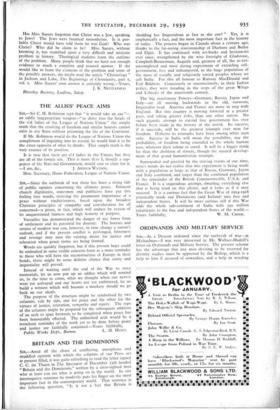THE ALLIES' PEACE AIMS
SIR,—Sir C. H. Robinson says that " it would take an axe "- an oddly inappropriate weapon—" to drive into the heads of the old ladies of the League of Nations Union " the simple truth that the crushing of freedom and similar horrors cannot exist in any State without poisoning the life of the Continent.
If Mr. Robinson would do the League of Nations Union the compliment of inquiring into its record, he would find it to be the exact opposite of what he thinks. That simple truth is the very essence of its position.
It is true that there are old ladies in the Union; but they are all of the female sex. This is more than I, though a sup- porter of the National Government, would care to clam for it.
Hon. Secretary, Hants Federation, League of Nations Union.
SIR,—Since the outbreak of war there has been a rising tide of public opinion concerning the ultimate peace. Eminent
church dignitaries, statesmen and publicists have put this feeling into words, stressing the paramount importance of a peace without vindictiveness, based upon the broadest Christian principles of sympathy and consideration for all concerned—a peace, in fact, which will endure by reason of its unquestioned fairness and high honesty of purpose.
Versailles has demonstrated the danger of any lower form of settlement and its potential for disaster. The horrors and strains of modern war can, however, in time change a nation's outlook, and if the present conflict is prolonged, bitterness and revenge may oust the existing desire for justice and toleration when peace terms are being framed.
Words are quickly forgotten, but if this present hope could be embodied in some visible concrete form as a mute reminder to those who will have the reconstruction of Europe in their hands, there might be some definite chance that sanity and impartiality will prevail.
Initead of waiting until the end of the War to erect memorials, let us now put up an edifice which will remind us, in the time to come, what we thought when our nerves were yet unfrayed and our hearts not yet embittered, let us build a witness which will become a mockery should we go back on our ideals.
The purpose of the structure might be symbolised by two columns, side by side, one for peace and the other for the virtues of justice, toleration, sympathy and equity. The tops of the columns might be prepared for the subsequent addition of an arch to span between, to be completed when peace has been honourably effected. The unfinished arch would be a trenchant reminder of the work yet to be done before peace and justice are faithfully conjoined.—Yours faithfully,






























 Previous page
Previous page